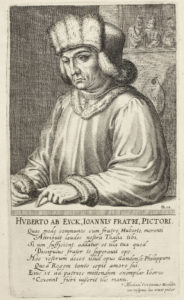
9. Hubert Van Eyck
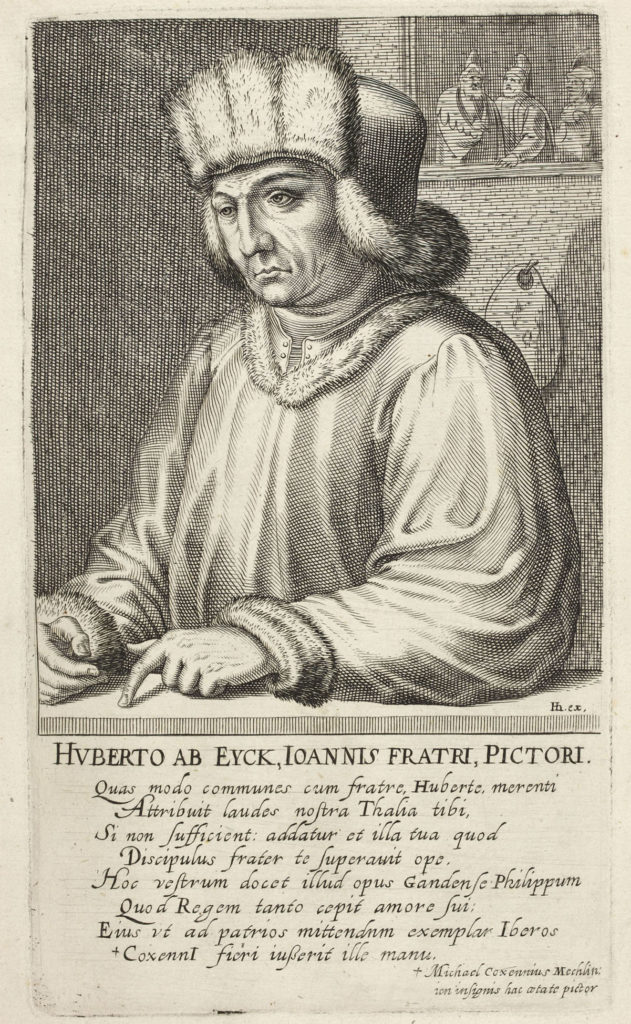
9. Hubert Van Eyck
Engraving
Signed 'Hh ex.' by Hendrick Hondius
Copy in same direction as Cock 1572 engraved Pictorum
20.7 x 12.0 cm
Transcription of Inscription [Lampsonius]:
HUBERTO AB EYCK, IOANNIS FRATRI, PICTORI.
Quas modo communes cum fratre, Huberte, merenti
Attribuit laudes nostra Thalia tibi,
Si non sufficient : addatur et illa tua quod
Discipulus frater te superavit ope.
Hoc vestrum docet illud opus Gandense Philippum
Quod Regem tanto cepit amore sui :
Eius ut ad patrios mittendum exemplar Iberos
+Coxennii fieri iusserit ille manu.
+Michael Coxennius Mechlin:
in insignis hac aetate pictor
Translation of Inscription [Lampsonius]:
To Hubert van Eyck, brother of Jan, painter.
Hubert, if the praises which our Thalia1 recently attributed to you along with your deserving brother are not enough, let this [praise] of yours be added, that your brother, as your student, outdid you in ability2 That work of yours in Ghent3 teaches this, which filled Philip with such love of it,4 that he ordered a copy of it to be made by the hand of Coxennius, to be sent to his native Spaniards.
Note (referring to Coxennius) – Michael Coxennius of Mechelen, a famous painter of that age.
Hollstein 1994 no. 82
Karel Van Mander's biography of Hubert van Eyck
Grove Art Online biography
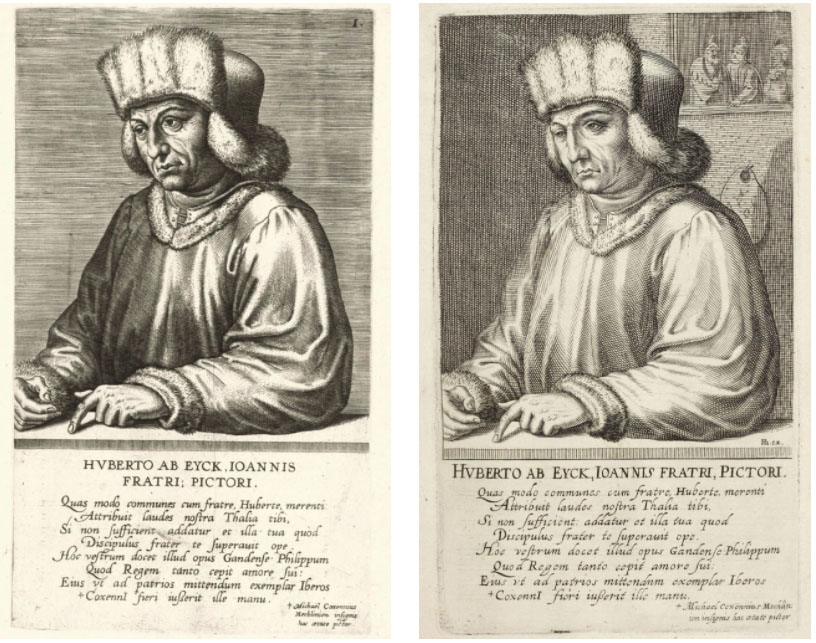 View the 1572 print
View the 1572 print
View both prints side by side
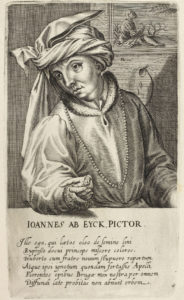
11. Jan Van Eyck
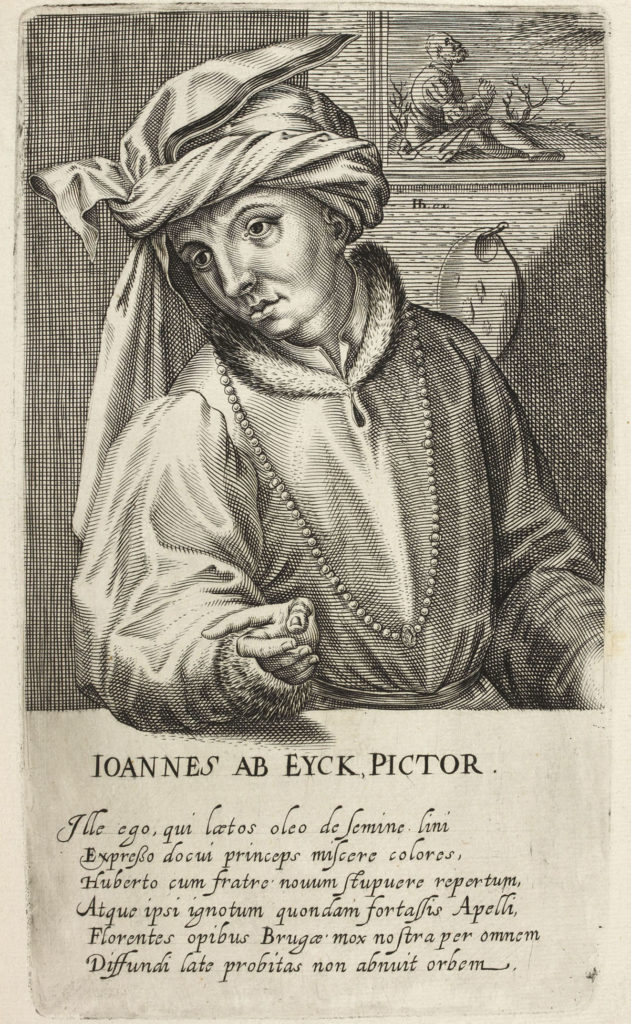
11. Jan Van Eyck
Engraving
Signed 'Hh ex.' by Hendrick Hondius
Copy in reverse direction to Cock 1572 engraved Pictorum
20.7 x 11.9 cm
Transcription of Inscription [Lampsonius]:
IOANNES AB EYCK, PICTOR.
Ille ego, qui laetos oleo de semine lini
Expresso docui princeps miscere colores,
Huberto cum fratre novum stupuere repertum,
Atque ipsi ignotum quondam fortassis Apelli,
Florentes opibus Brugae mox nostra per omnem
Diffundi late probitas non abnuit orbem.
Translation of Inscription [Lampsonius]:
Jan van Eyck, painter
I am he who 5 first taught to mix joyful colours from the pressed oily seed of flax, 6 with my brother Hubert. Bruges, flourishing with wealth, was astounded by this new discovery, perhaps unknown in the past to Apelles himself. Soon afterwards our uprightness 7 did not refuse to be spread widely through the whole world.
Hollstein 1994 no. 83
Karel Van Mander's biography of Jan van Eyck
Grove Art Online biography
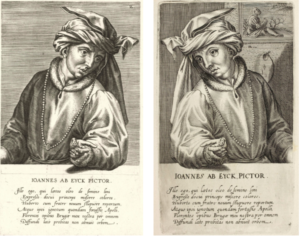 View the 1572 print
View the 1572 print
View both prints side by side
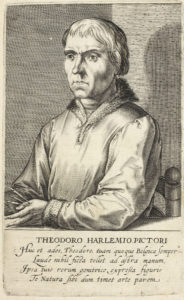
13. Dirck Bouts
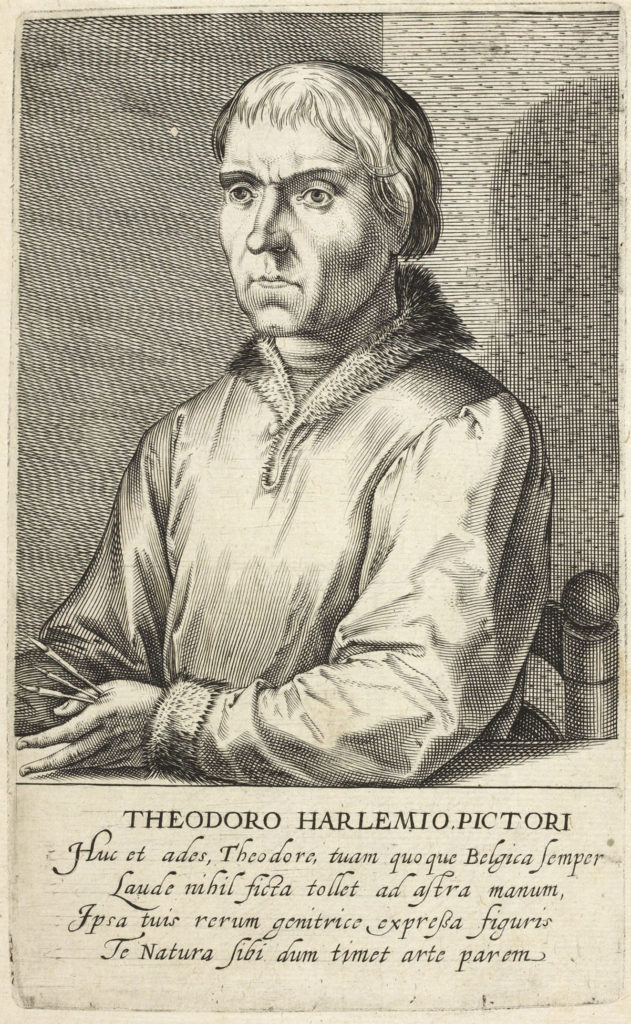
13. Dirck Bouts
Engraving
Attributed to Hendrick Hondius
Copy in reverse direction to Cock 1572 engraved Pictorum
19.2 x 11.8 cm
Transcription of Inscription [Lampsonius]:
THEODORO HARLEMIO PICTORI
Huc et ades, Theodore, tuam quoque Belgica semper
Laude nihil ficta tollet ad astra manum,
Ipsa tuis rerum genitrice expressa figuris
Te Natura sibi dum timet arte parem
Translation of Inscription [Lampsonius]:
To Dirck Bouts, painter
You are here too, Theodore. Belgium shall always also raise your hand to the stars with no false praise, while Nature, expressed by your figures, fears you, equal to her in the art of begetting things. 8
Hollstein 1994 no. 84
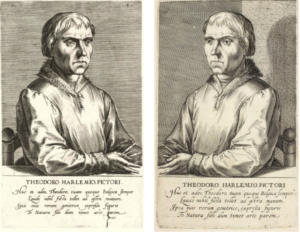
View the 1572 print
View both prints side by side
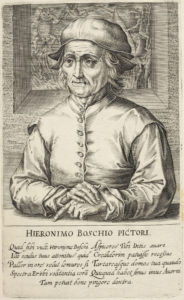
15. Hieronymus Bosch
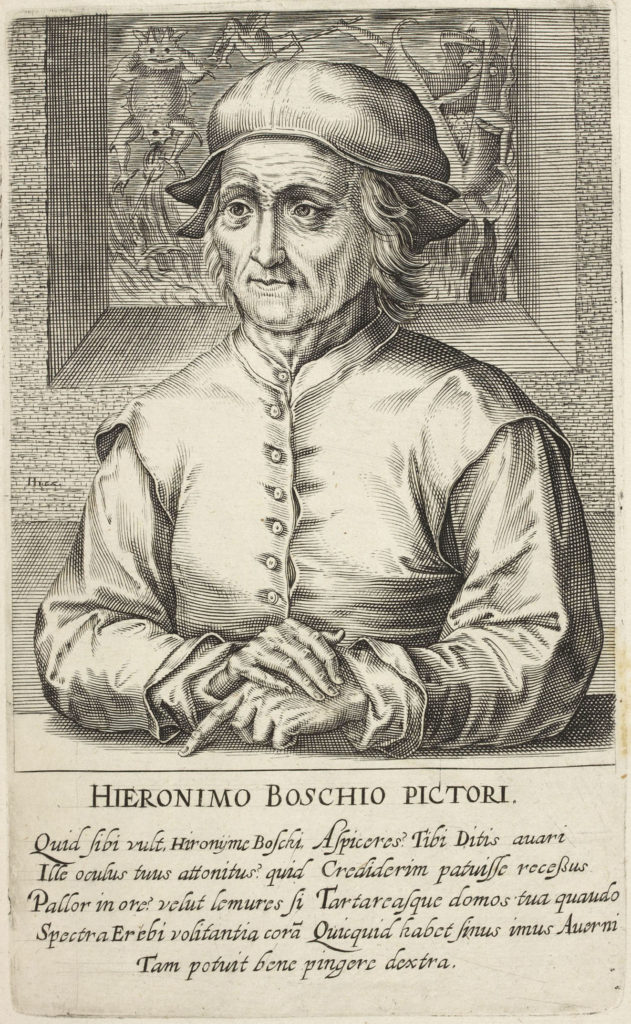
15. Hieronymus Bosch
Engraving, second state.
Signed 'Hh ex.' by Hendrick Hondius
Copy in reverse direction as Cock 1572 engraved Pictorum
19.8 x 12.0 cm
Transcription of Inscription [Lampsonius]:
HIERONIMO BOSCHIO PICTORI.
Quid sibi vult, Hironyme Boschi,
Ille oculus tuus attonitus? quid
Pallor in ore? velut lemures si
Spectra Erebi volitantia coram
Aspiceres? Tibi Ditis avari
Crediderim patuisse recessus
Tartareasque domos tua quando
Quicquid habet sinus imus Averni
Tam potuit bene pingere dextra.
Translation of Inscription [Lampsonius]:
To Hieronymus Bosch, painter.
What is meant by that astonished eye of yours, Hieronymus Bosch, or that pallor in your face? As if you had seen ghosts, the spectres of Erebus, flittering in front of you. I could believe that the caves of greedy Pluto and the houses of Tartarus lay open to you, seeing as your hand could paint so well whatever the lowest hollows of Avernus 9 contain.
Hollstein 1994 no. 85
Karel Van Mander's biography of Hieronymus Bosch.
Grove Art Online biography.
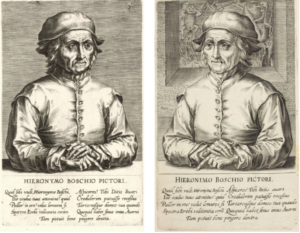
View the 1572 print
View both prints side by side
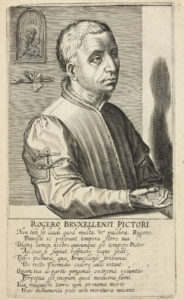
17. Rogier Van Der Weyden
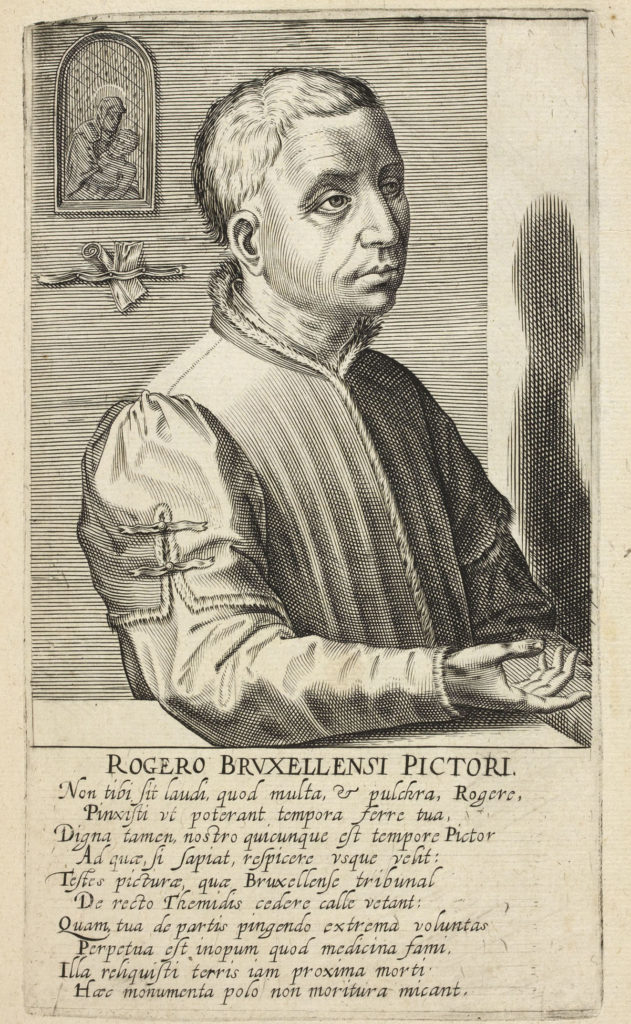
17. Rogier Van Der Weyden
Engraving
Attributed to Hendrick Hondius
Copy in same direction as Cock 1572 engraved Pictorum
21.0 x 12.1 cm
Transcription of Inscription [Lampsonius]:
ROGERO BRUXELLENSI PICTORI.
Non tibi sit laudi, quod multa, et pulchra, Rogere,
Pinxisti ut poterant tempora ferre tua,
Digna tamen, nostro quicunque est tempore Pictor
Ad quae, si sapiat, respicere usque velit :
Testes picturae, quae Bruxellense tribunal
De recto Themidis cedere calle vetant :
Quam tua de partis pingendo extrema voluntas
Perpetua est inopum quod medicina fami.
Illa reliquisti terris iam proxima morti ;
Haec monumenta polo non moritura micant.
Translation of Inscription [Lampsonius]:
To Rogier van der Weyden, painter.
May your praise not be that you painted many beautiful things, as your age could bear them 10 (although they are worthy that anyone who is a painter in our time wish greatly to look at them, if he be wise – the paintings which forbid the tribunal of Brussels to leave the straight path of Justice are witness [to this]): but rather that your last will is a perpetual remedy for the hunger of the poor from the proceeds of your painting. The former, [itself] already near to death, you left on earth; the latter shines in the sky, as a monument that will not die.11
Hollstein 1994 no. 86
Karel Van Mander's biography of Rogier van der Weyden
Grove Art Online biography
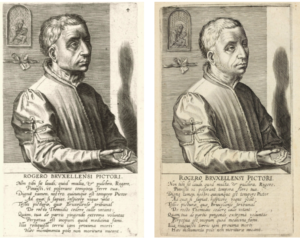
View the 1572 print
View both prints side by side
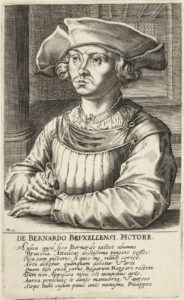
19. Bernaert Van Orley
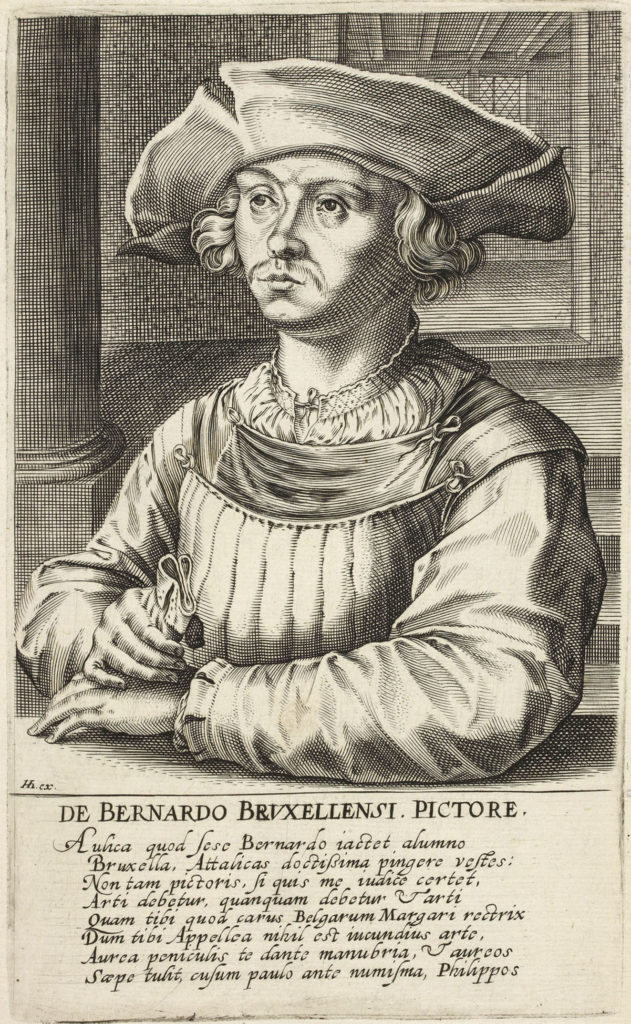
19. Bernaert Van Orley
Engraving, second state
Signed 'Hh ex.' by Hendrick Hondius
Copy in reverse direction to Cock 1572 engraved Pictorum
20.1 x 12.0 cm
Transcription of Inscription [Lampsonius]:
DE BERNARDO BRUXELLENSI. PICTORE.
Aulica quod sese Bernardo iactet alumno
Bruxella, Attalicas doctissima pingere vestes :
Non tam pictoris, si quis me iudice certet,
Arti debetur, quanquam debetur et arti
Quam tibi quod carus Belgarum Margari rectrix
Dum tibi Appellea nihil est iucundius arte,
Aurea peniculis te dante manubria, et aureos
Saepe tulit, cusum paulo ante numisma, Philippos
Translation of Inscription [Lampsonius]:
About Bernaert van Orley, painter.
That the Court of Brussels boasts of its nursling Bernaert, most skilled12 in painting Attalian13 garments, is not so much due (if anyone wants to argue while I am judging14) to the painter’s skill (although it is also due to his skill) as it is to [the fact] that he was dear to you, Margaret ruler of the Belgians, since nothing is more delightful to you than the art of Apelles. By your gift, he often got golden handles for his paintbrushes, and gold coins, in recently minted currency.
Hollstein 1994 no. 87
Karel Van Mander's biography of Bernaert van Orley
Grove Art Online biography
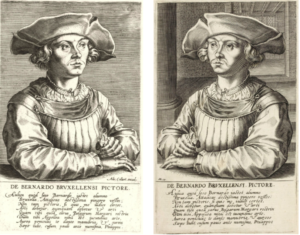
View the 1572 print
View both prints side by side
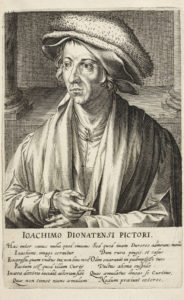
21. Joachim Patinir
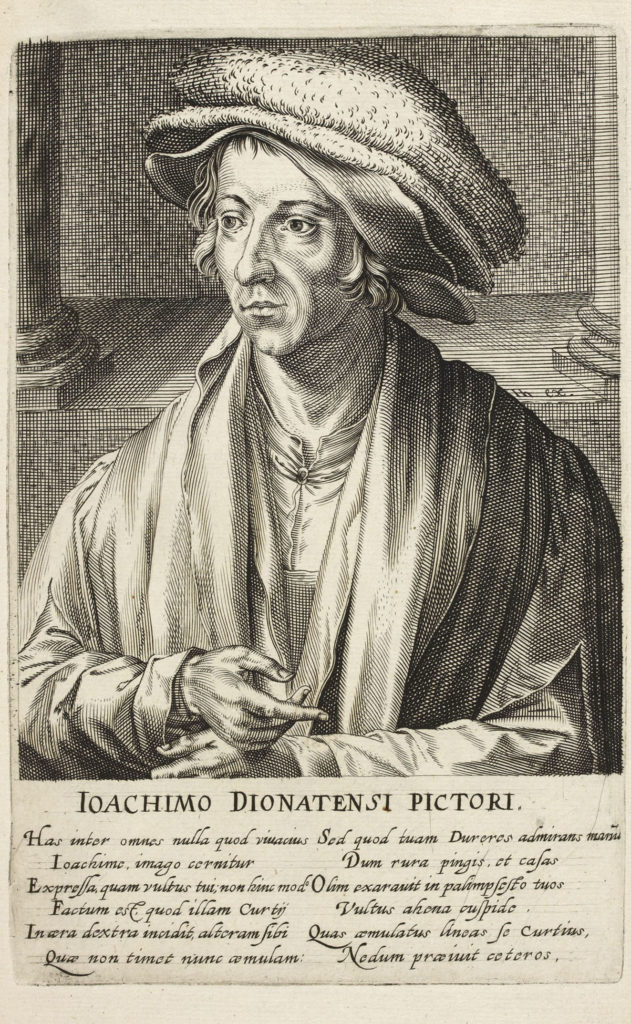
21. Joachim Patinir
Engraving
Signed 'Hh ex.' by Hendrick Hondius
Copy in reverse direction to Cock 1572 engraved Pictorum
19.1 x 12.3 cm
Transcription of Inscription [Lampsonius]:
IOACHIMO DIONATENSI PICTORI.
Has inter omnes nulla quod vivacius
Ioachime, imago cernitur
Expressa, quam vultus tui ; non hinc modo
Factus est, quod illam Curtii
In aera dextra incidit, alteram sibi
Quae non timet nunc aemulam :
Sed quod tuam Dureres admirans manum
Dum rura pingis, et casas
Olim exaravit in palimpsesto tuos
Vultus ahena cuspide.
Quas aemulatus lineas se Curtius,
Nedum praeivit ceteros.
Translation of Inscription [Lampsonius]:
To Joachim Patenir, painter.
That, amongst all of these, no image expressed with more liveliness than your face is to be seen, Joachim, has happened not only because Curtius'15 hand cut it into the bronze ([the hand] which does not now fear another rival), but [also] because Dürer, admiring your hand, when you painted fields and huts,16 once drew your face on a palimpsest17 with his bronze point. Imitating those lines, Curtius surpassed himself, not to mention all the others.
Hollstein 1994 no. 88
Karel Van Mander's biography of Joachim Patinir
Grove Art Online biography
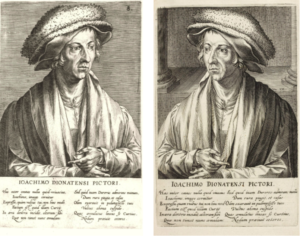
View the 1572 print
View both prints side by side
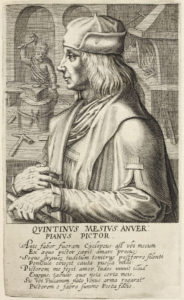
23. Quentin Matsys
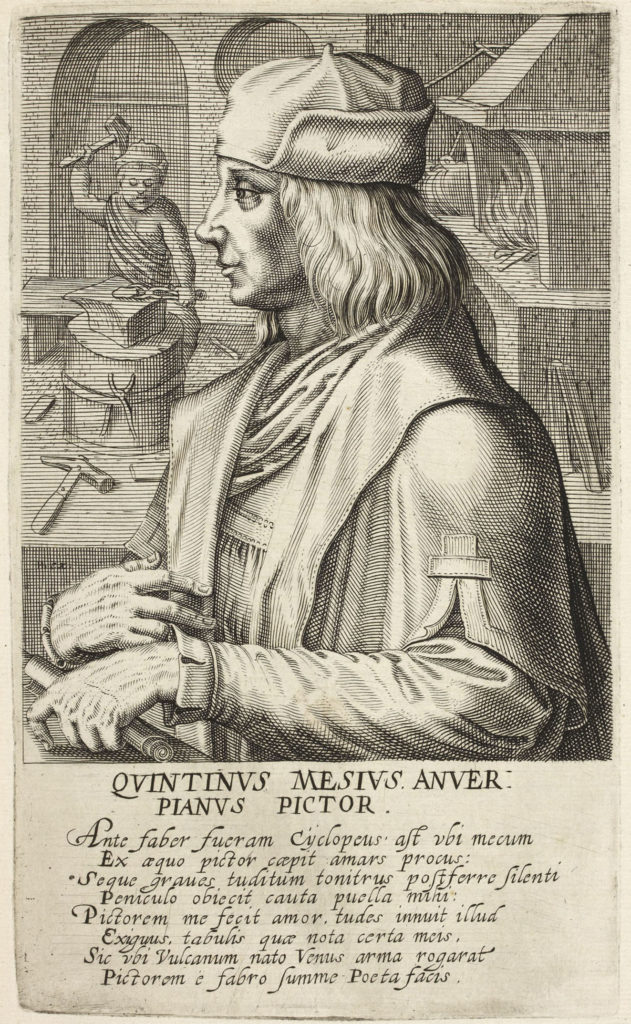
23. Quentin Matsys
Engraving
Signed 'Hh ex.' by Hendrick Hondius
Copy in same direction as Cock 1572 engraved Pictorum
20.4 x 12.0 cm
Transcription of Inscription [Lampsonius]:
QUINTINUS MESIUS. ANVER:PIANUS PICTOR.
Ante faber fueram Cyclopeus ; ast ubi mecum
Ex aequo pictor coepit amars18 procus :
Seque graves tuditum tonitrus postferre silenti
Peniculo obiecit cauta puella mihi :
Pictorem me fecit amor. tudes innuit illud
Exiguus, tabulis quae nota certa meis,
Sic ubi Vulcanum nato Venus arma rogarat
Pictorem e fabro summe Poeta facis.
Translation of Inscription [Lampsonius]:
To Quentin Matsys, painter of Antwerp.
Before I used to be a Cyclopean smith,19 but when a wooing painter began to love20 on an equal footing with me, and the cautious girl objected to me that she liked the heavy thundering of hammers less than the silent paintbrush, love made me a painter. A tiny hammer, which is the sure note of my paintings, alludes to this. Thus, when Venus had asked Vulcan for arms for her son, you, greatest of poets, made a painter out of a smith.21
Hollstein 1994 no.89
Karel Van Mander's biography of Quentin Matsys
Grove Art Online biography
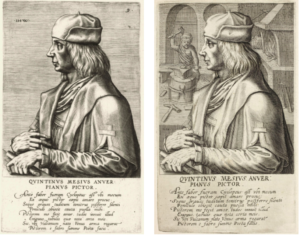
View the 1572 print
View both prints side by side
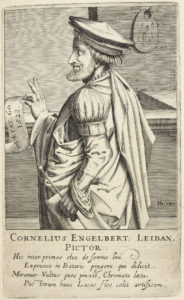
25. Cornelius Engebrechtsz

25. Cornelius Engebrechtsz
Engraving
Signed 'Hh exc.' by Hendrick Hondius
20.5 x 12.4 cm
Transcription of Inscription [Lampsonius]:
CORNELIUS ENGELBERT. LEIDAN. PICTOR.
Hic inter primos oleo de semine lini
Expresso in Batavis pingere qui didicit.
Miramur Vultus quos pinxit, Chromata laeta.
Pictorum hunc Lucas flos colit artificem.
Translation of Inscription [Lampsonius]:
Cornelis Engelbrechtsz. Painter of Leyden.
This man was among the first of the Dutch who learnt to paint with pressed oily seed of flax.22 We wonder at the faces [and] joyful colours which he painted. Lucas, the flower of painters, frequented this artist.
Hollstein 1994 no.90
Karel Van Mander's biography of Cornelius Engebrechtsz
Grove Art Online biography
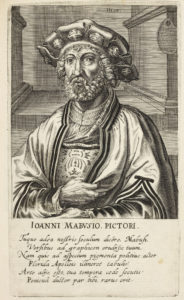
27. Jan Gossaert, called Mabuse
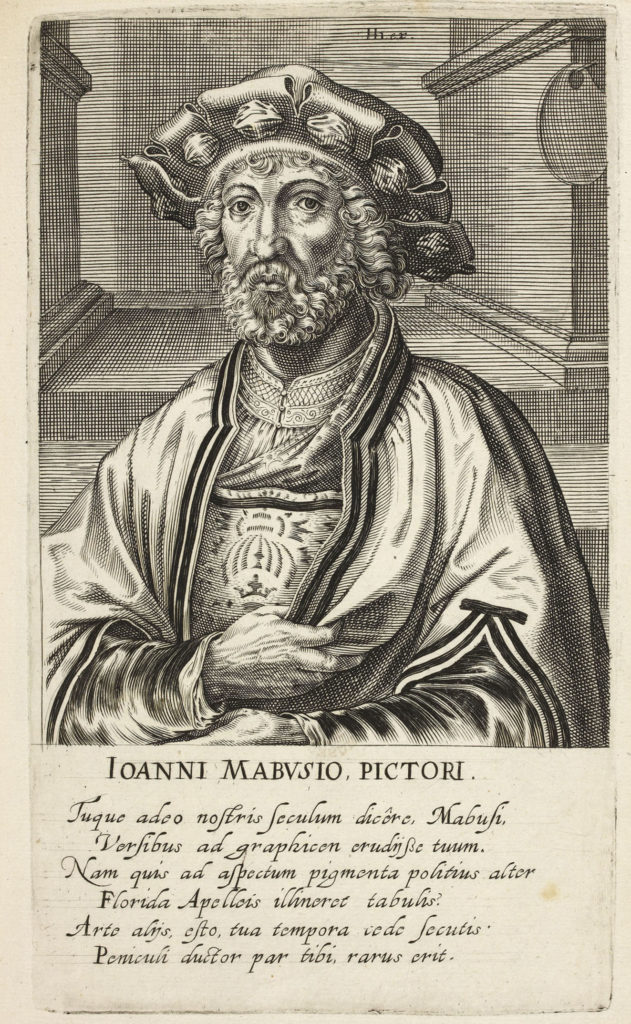
27. Jan Gossaert, called Mabuse
Engraving, second state
Signed 'Hh ex.' by Hendrick Hondius
Copy in reverse direction as Cock 1572 engraved Pictorum
20.9 x 12.2 cm
Transcription of Inscription [Lampsonius]:
IOANII MABUSIO, PICTORI.
Tuque adeo nostris seculum dicêre, Mabusi,
Versibus ad graphicen erudiisse tuum.
Nam quis ad aspectum pigmenta politius alter
Florida Apelleis illineret tabulis?
Arte aliis, esto, tua tempora cede secutis ;
Peniculi ductor par tibi, rarus erit.
Translation of Inscription [Lampsonius]:
To Jan Gossaert, painter.
You too, indeed, man of Maubeuge, will be said in our verses to have educated your age in drawing. For who else could daub Apelles’ boards23 with flowering pigments smoother to the eye? Granted, you yield in skill to others who followed your age. [But] rare will be the guider of the brush who is equal to you.
Hollstein 1994 no.91
Karel Van Mander's biography of Jan Gossaert
Grove Art Online biography
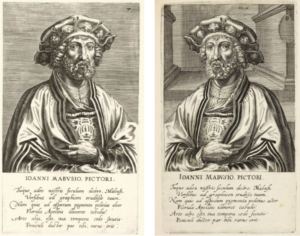
View the 1572 print
View both prints side by side
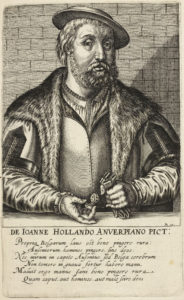
29. Jan van Amstel
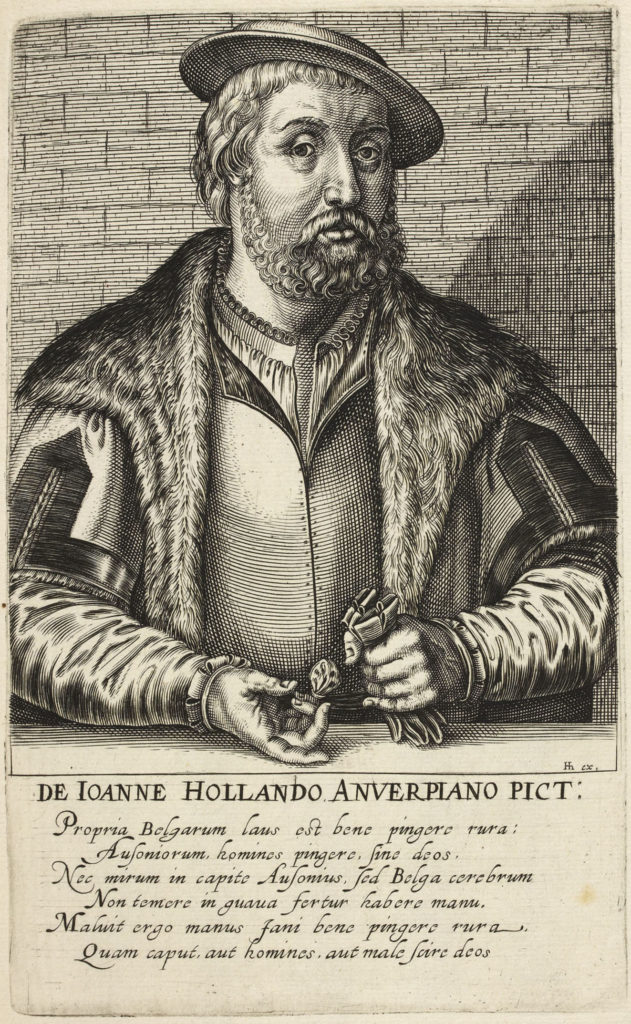
29. Jan van Amstel
Engraving
Signed 'Hh ex.' by Hendrick Hondius
Copy in reverse direction as Cock 1572 engraved Pictorum
20.1 x 12.3 cm
Transcription of Inscription [Lampsonius]:
DE JOANNE HOLLANDO, ANVERPIANO PICT :
Propria Belgarum laus est bene pingere rura :
Ausoniorum, homines pingere, sine24 deos.
Nec mirum in capite Ausonius, sed Belga cerebrum
Non temere in guava25 fertur habere manu.
Maluit ergo manus Jani bene pingere rura
Quam caput, aut homines, aut male scire deos.
Translation of Inscription [Lampsonius]:
To Jan van Amstel, painter of Antwerp 26
The proper praise of Belgians is to paint fields well; that of Italians to paint men or gods. Nor is it surprising: not without reason is the Italian said to have his brain in his head, [while] the Belgian [has his] in his active hand. Jan’s hand, then, preferred to paint fields well, than for his head to know poorly either men or gods.
Hollstein 1994 no.92
Karel Van Mander's biography of Jan van Amstel
Grove Art Online biography
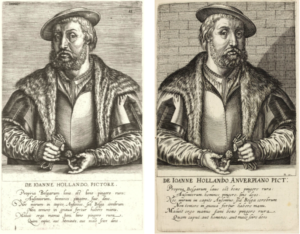
View the 1572 print
View both prints side by side
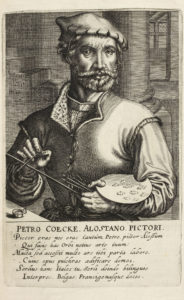
31. Pieter Coecke van Aelst
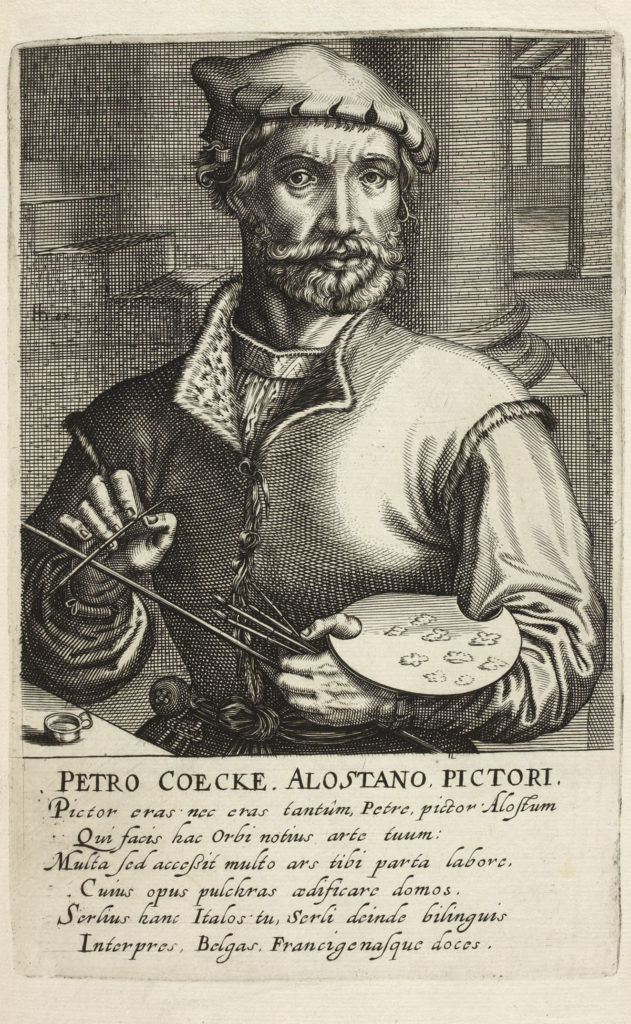
31. Pieter Coecke van Aelst
Engraving
Signed 'Hh ex.' by Hendrick Hondius
Copy in same direction as Cock 1572 engraved Pictorum
19.3 x 12.6 cm
Transcription of Inscription [Lampsonius]:
PETRO COECKE. ALOSTANO, PICTORI.
Pictor eras nec eras tantûm, Petre, pictor ; Alostum
Qui facis hac Orbi notius arte tuum :
Multa sed accessit multo ars tibi parta labore,
Cuius opus pulchras aedificare domos.
Serlius hanc Italos ; tu, Serli deinde bilinguis
Interpres, Belgas, Francigenasque doces.
Translation of Inscription [Lampsonius]:
To Pieter Coecke van Aelst, painter.
You were a painter, but, Pieter, you were not only a painter, you who made your Aelst27 more known to the world by this skill. But there was much skill in addition, born to you by much labour. Its office was to build beautiful houses. Serlio taught this to the Italians, then you, bilingual interpreter of Serlio, taught the Belgians and the French.
Hollstein 1994 no.93
Karel Van Mander's biography of Pieter Coecke van Aelst
Grove Art Online biography
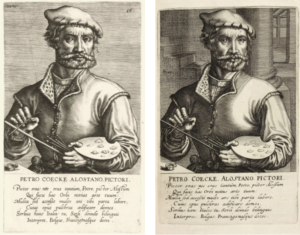
View the 1572 print
View both prints side by side
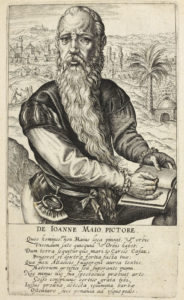
33. Jan Vermeyen
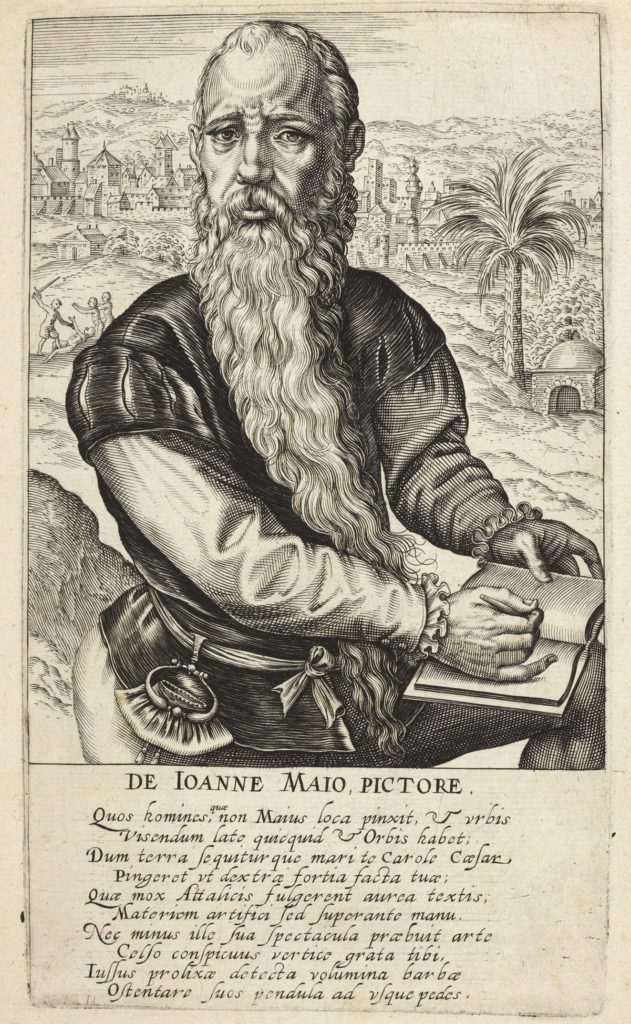
33. Jan Vermeyen
Engraving
Attributed to Hendrick Hondius
Copy in reverse direction to Cock 1572 engraved Pictorum
20.6 x 11.8 cm
Transcription of Inscription [Lampsonius]:
DE IOANNE MAIO, PICTORE.
Quos homines, quae non Maius loca pinxit, et urbis28
Visendum late quicquid et Orbis habet ;
Dum terra sequiturque mari te Carole Caesar
Pingeret ut dextrae fortia facta tuae ;
Quae mox Attalicis fulgerent aurea textis,
Materiem artifici sed superante manu.
Nec minus ille sua spectacula praebuit arte
Celso conspicuus vertice grata tibi,
Iussus prolixae detecta volumina barbae
Ostentare suos pendula ad usque pedes.
Translation of Inscription [Lampsonius]:
About Jan Vermeyen, painter.
What men, what places and what cities29 has Vermeyen not painted? –– and whatever the world, far and wide, has worth seeing - while he followed you on land and sea, Emperor30 Charles, to paint the mighty deeds of your hand. These soon shone in gold with Attalian31 embroidery, although the artist’s hand was greater than the material.32 Nor did he provide a sight less pleasing to you than his art – [he was] remarkable for his high forehead, [and] was ordered to show off the unhidden folds of his rich beard, hanging down to his feet.
Hollstein 1994 no.94
Karel Van Mander's biography of Jan Vermeyen
Grove Art Online biography
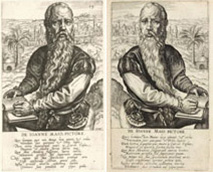
View the 1572 print
View both prints side by side
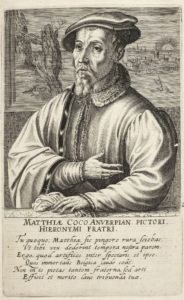
35. Mathys Cock
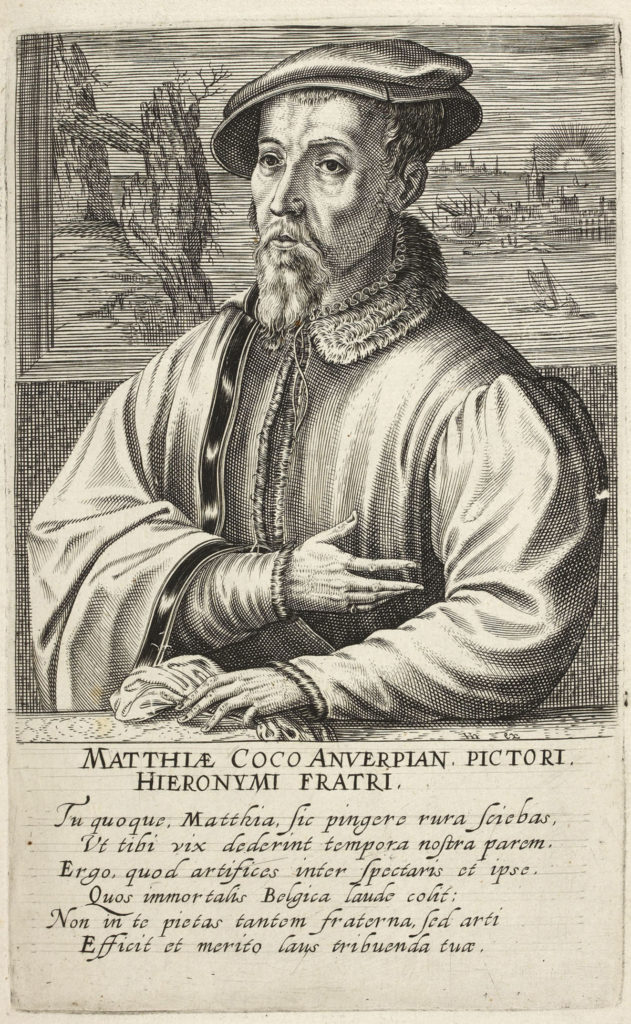
35. Mathys Cock
Engraving
Attributed to Hendrick Hondius
Copy in reverse direction to Cock 1572 engraved Pictorum
19.6 x 12.4cm
Transcription of Inscription [Lampsonius]:
MATTHIÆ COCO ANVERPIAN. PICTORI. HIERONYMI FRATRI.
Tu quoque, Matthia, sic pingere rura sciebas,
Ut tibi vix dederint tempora nostra parem.
Ergo, quod artifices inter spectaris et ipse,
Quos immortalis33 Belgica laude colit ;
Non in te pietas tantem34 fraterna, sed arti
Efficit et merito laus tribuenda tuae.
Translation of Inscription [Lampsonius]:
To Matthias Cock of Antwerp, painter, brother of Hieronymus.
You too, Matthias, knew how to paint fields in such a way, that our age has scarcely produced your equal. Therefore, if you too are considered among the artists whom Belgium honours with immortal35 praise, not only36 fraternal piety grants this to you, but also the praise justly due to your skill.
Hollstein 1994 no.95
Karel Van Mander's biography of Mathys Cock
Grove Art Online biography
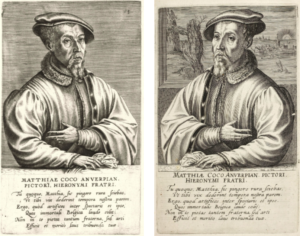
View the 1572 print
View both prints side by side
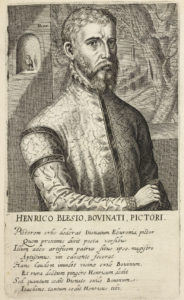
37. Henri Met de Bles
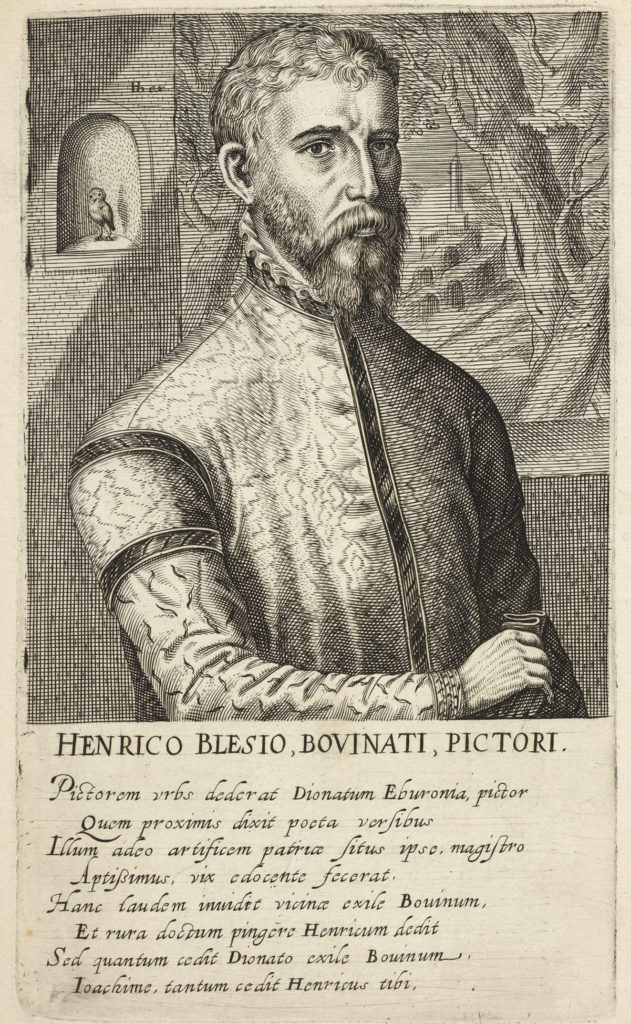
37. Henri Met de Bles
Engraving, second state
Signed 'Hh ex.' by Hendrick Hondius
Copy in reverse direction to Cock 1572 engraved Pictorum
20.6 x 12.3 cm
Transcription of Inscription [Lampsonius]:
HENRICO BLESIO, BOVINATI, PICTORI.
Pictorem urbs dederat Dionatum Eburonia, pictor
Quem proximis dixit poeta versibus
Illum adeo artificem patriae situs ipse, magistro
Aptissimus, vix edocente fecerat.
Hanc laudem invidit vicinae exile Bovinum,
Et rura doctum pingere Henricum dedit
Sed quantum cedit Dionato exile Bovinum
Ioachime, tantum cedit Henricus tibi.
Translation of Inscription [Lampsonius]:
To Herri met de Bles of Bouviges, painter.
The Eburonian city37 had produced the painter of Dinant, the painter of whom the poet spoke in recent verses. The most favourable site of his homeland had made him entirely an artist, and a master hardly taught him. Tiny Bouviges was jealous of this its neighbour’s glory and produced Hendrik, learned in painting fields. But, Joachim, as much as tiny Bouviges yields to Dinant [in size], so much does Hendrik yield to you.
Hollstein 1994 no.96
Karel Van Mander's biography of Henri met de Bles
Grove Art Online biography
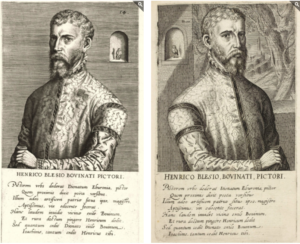
View the 1572 print
View both prints side by side
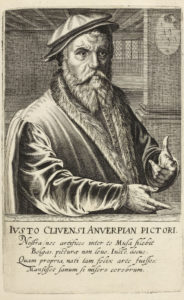
39. Joos van Cleve
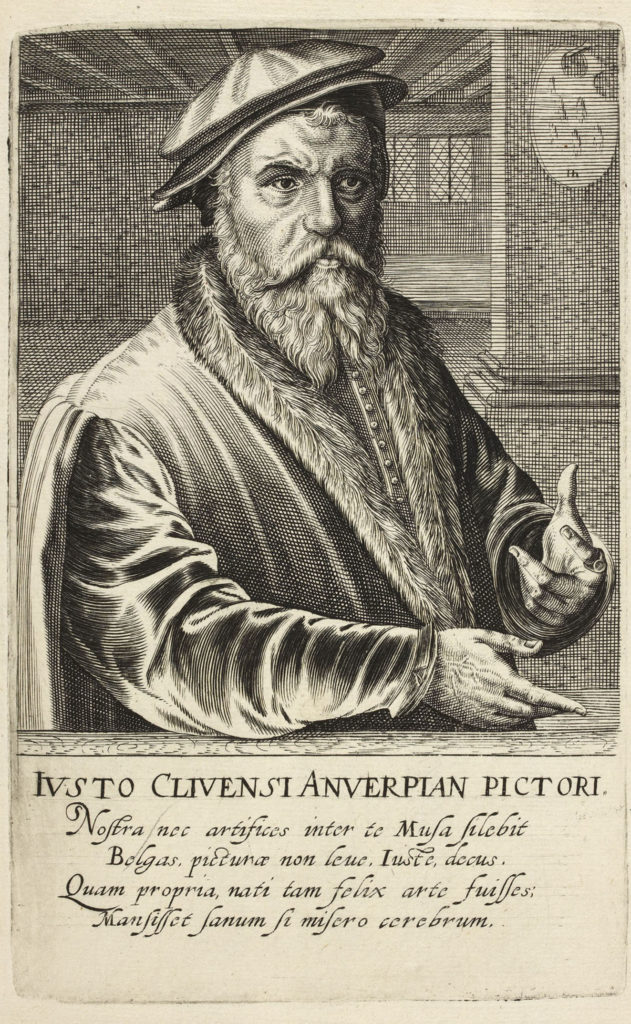
39. Joos van Cleve
Engraving
Signed 'Hh' by Hendrick Hondius
Copy in reverse direction to Cock 1572 engraved Pictorum
19.3 x 12.1 cm
Transcription of Inscription [Lampsonius]:
IUSTO CLIVENSI ANVERPIAN PICTORI.
Nostra nec artifices inter te Musa silebit
Belgas, picturae non leve, Iuste, decus.
Quam propria, nati tam felix arte fuisses ;
Mansisset sanum si misero cerebrum.
Translation of Inscription [Lampsonius]:
To Joos van Cleve of Antwerp, painter.
Our muse shall not keep silent about you, among the Belgian artists, Joos, [you who are ] no trivial glory of painting. You would have been as happy in your son’s art as in your own, if only the wretch’s brain had remained healthy.
Hollstein 1994 no. 97
Karel Van Mander's biography of Joos van Cleve
Grove Art Online biography
View the 1572 print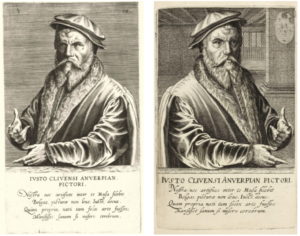
View both prints side by side
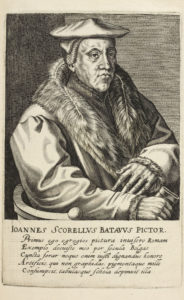
41. Jan van Scorel
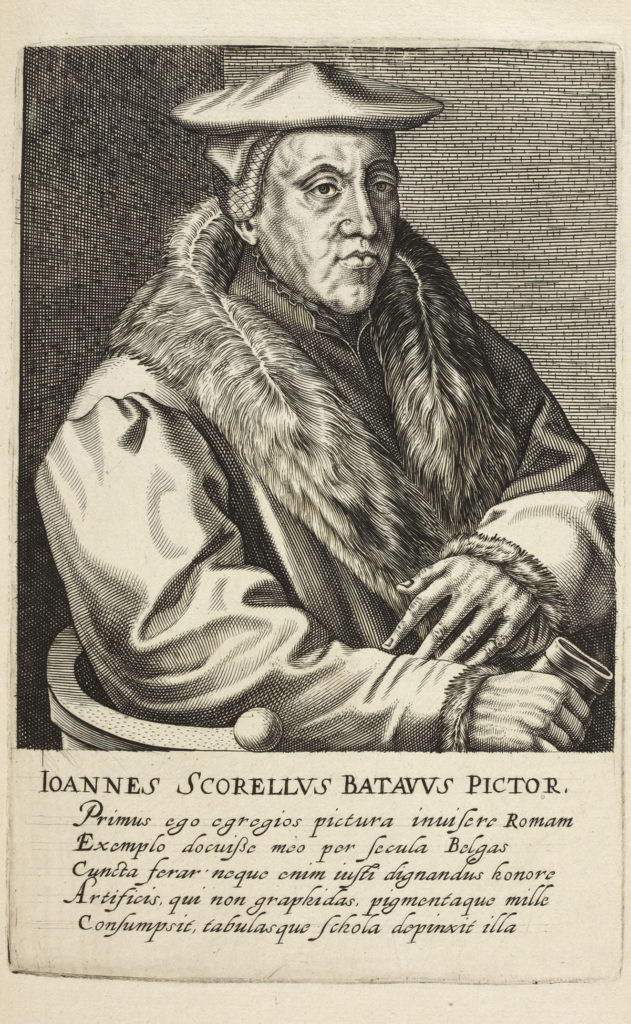
41. Jan van Scorel
Engraving, second state
Attributed to Hendrick Hondius
Copy in reverse direction to Cock 1572 engraved Pictorum
19.5 x 12.7 cm
Transcription of Inscription [Lampsonius]:
IOANNES SCORELLUS BATAVUS PICTOR.
Primus ego egregios pictura invisere Romam
Exemplo docuisse meo per secula Belgas
Cuncta ferar ; neque enim iusti dignandus honore
Artificis, qui non graphidas, pigmentaque mille
Consumpsit, tabulasque schola depinxit illa38
Translation of Inscription [Lampsonius]:
Jan van Scorel, Dutch painter.
Through all centuries I shall be said to have been the first to have taught by my example the excellent Belgians to be envious of Rome in painting. For he is not worthy of the honour of a true artist, who does not use up a thousand pencils and pigments, and paint pictures in that school.39
Hollstein 1994 no.98
Karel Van Mander's biography of Jan van Scorel
Grove Art Online biography
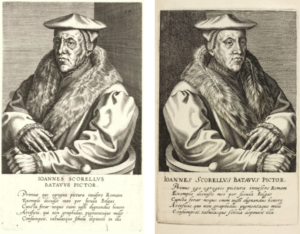
View the 1572 print
View both prints side by side
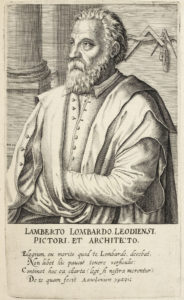
43. Lambert Lombard
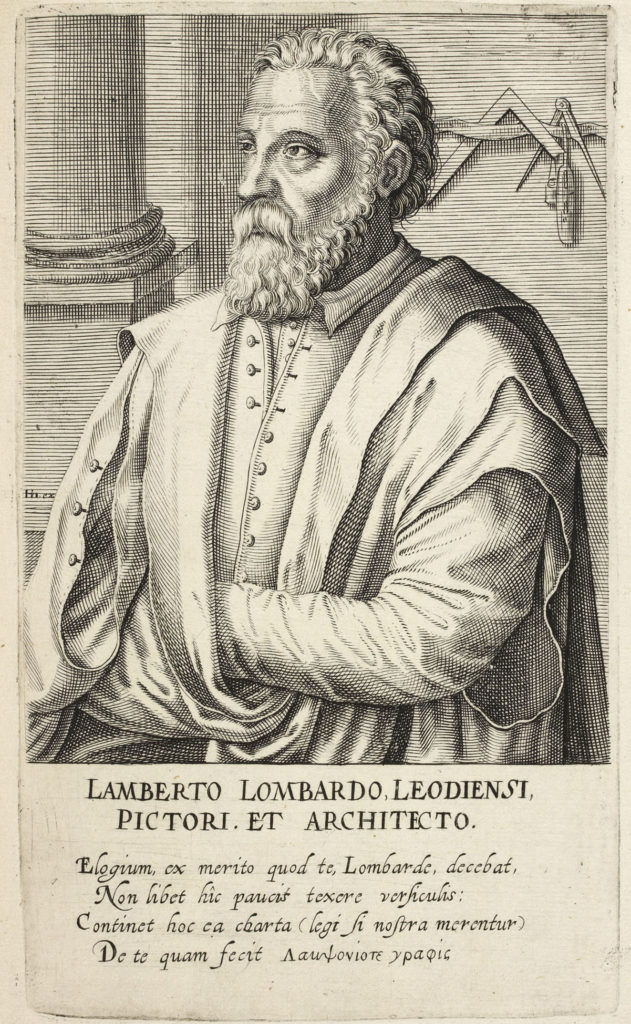
43. Lambert Lombard
Engraving, second state
Signed 'Hh ex.' by Hendrick Hondius
Copy in same direction as Cock 1572 engraved Pictorum
20.1 x 11.9 cm
Transcription of Inscription [Lampsonius]:
LAMBERTO LOMBARDO, LEODIENSIS PICTORI. ET ARCHITECTO.
Elogium, ex merito quod te, Lombarde, decebat,
Non libet hîc paucis texere versiculis :
Continet hoc ea charta (legi si nostra merentur)
De te quam fecit Λαμψονίοτε γραφίς
Translation of Inscription [Lampsonius]:
To Lambert Lombard of Liège, painter and architect
It does not please [me], Lombard, to write here in a few verses an epigraph which would be suitable to your merits. Those pages contain it which (if our works deserve to be read) the Lampsonian pen40 wrote about you.
Hollstein 1994 no. 99
Karel Van Mander's biography of Lambert Lombard
Grove Art Online biography
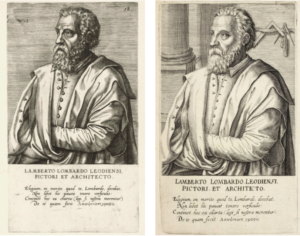
View the 1572 print
View both prints side by side
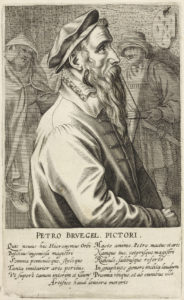
45. Pieter Bruegel
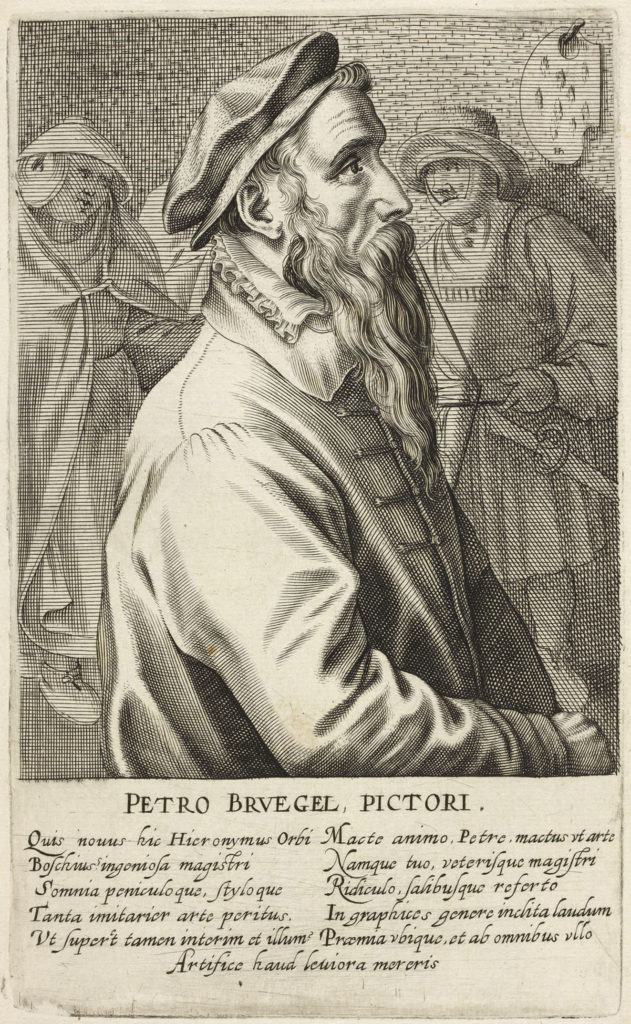
45. Pieter Bruegel
Engraving, second state
Signed 'Hh' by Hendrick Hondius
Copy in reverse direction to Cock 1572 engraved Pictorum
19.2 x 11.7 cm
Transcription of Inscription [Lampsonius]:
PETRO BRVEGEL, PICTORI.
Quis novus hic Hieronymus Orbi
Boschius ? ingeniosa magistri
Somnia peniculoque, styloque
Tanta imitarier arte peritus.
Ut superet tamen interim et illum ?
Macte animo, Petre, mactus ut arte
Namque tuo, veterisque magistri
Ridiculo, salibusque referto
In graphices genere inclita laudum
Praemia ubique, et ab omnibus ullo
Artifice haud leviora mereris
Translation of Inscription [Lampsonius]:
To Pieter Bruegel, painter.
Who is this new Hieronymus Bosch for the world, versed in imitating the master’s ingenious dreams with such great skill of paintbrush and pen – so that sometimes he surpasses even him. Pieter, [you are] blessed in your spirit, as you are blessed in your skill, for in your own and your old master’s comic type of painting, full of wit, you deserve glorious rewards of praise, everywhere and from everyone, no less than those of any artist.
Hollstein 1994 no.100
Karel Van Mander's biography of Pieter Bruegel
Grove Art Online biography
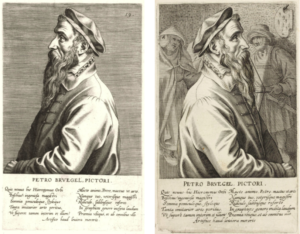
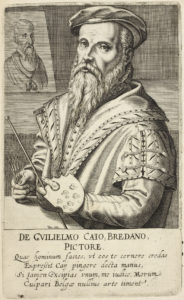
47. Willem Key
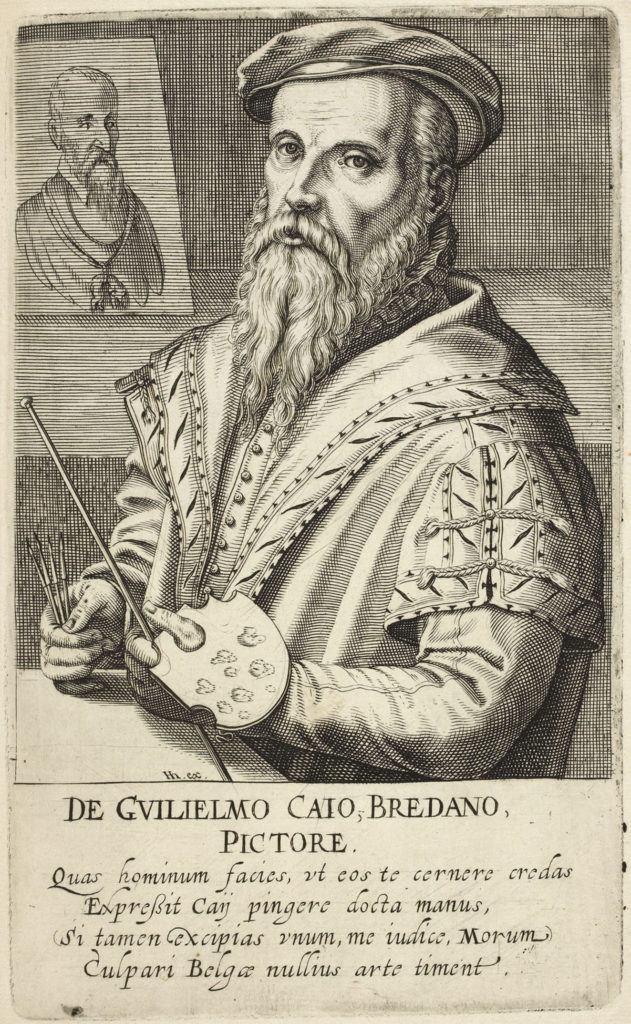
47. Willem Key
Engraving
Signed 'Hh ex.' by Hendrick Hondius
Copy in reverse direction to Cock 1572 engraved Pictorum
19.8 x 12.0 cm
Transcription of Inscription [Lampsonius]:
DE GUILIELMO CAIO, BREDANO, PICTORE.
Quas hominum facies, ut eos te cernere credas
Expressit Caii pingere docta manus,
(Si tamen excipias unum, me iudice, Morum)
Culpari Belgae nullius arte timent.
Translation of Inscription [Lampsonius]:
About Willem Key of Breda, painter.
What faces of people the hand of Key, learned in painting, expressed, so that you could believe you were looking at them!41 – if however, you except one, Mor,42 in my opinion the Belgians do not fear to be found wanting because of anyone’s skill.
Hollstein 1994 no.101
Karel Van Mander's biography of William Key
Grove Art Online biography
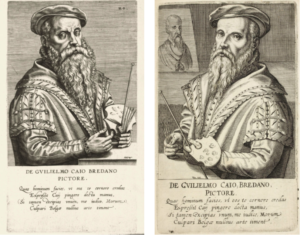
View the 1572 print
View both prints side by side
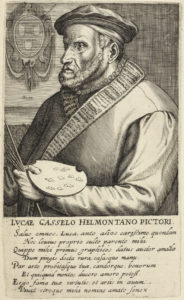
49. Lucas Gassel
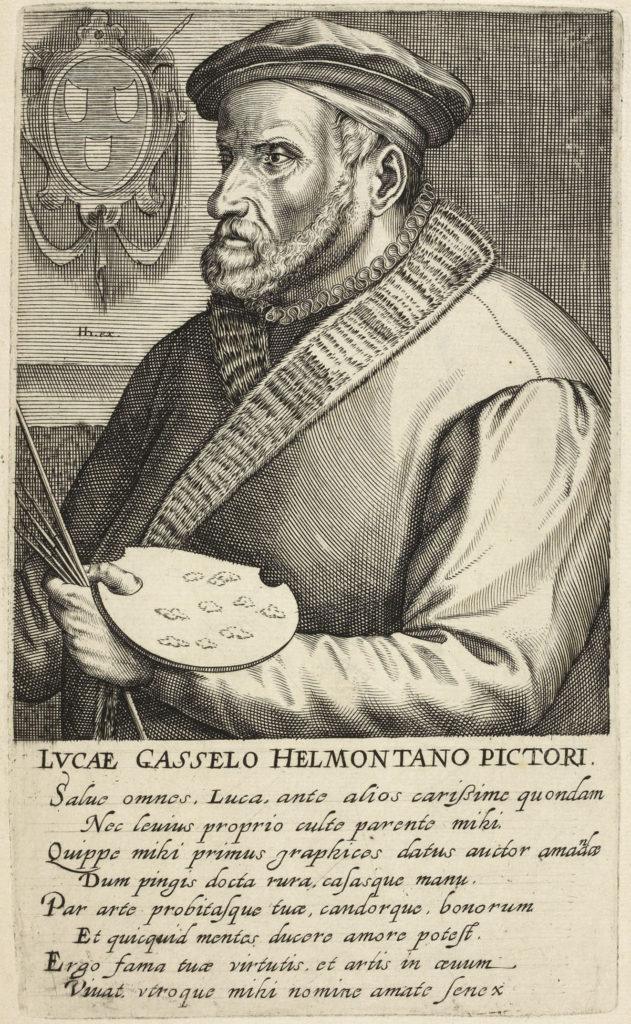
49. Lucas Gassel
Engraving, second state
Signed 'Hh ex.' by Hendrick Hondius
Copy in same direction as Cock 1572 engraved Pictorum
20.4 x 12.1 cm
Transcription of Inscription [Lampsonius]:
LUCÆ GASSELO HELMONTANO PICTORI.
Salve omnes, Luca, ante alios carissime quondam
Nec levius proprio culte parente mihi.
Quippe mihi primus graphices datus auctor amandae
Dum pingis docta rura, casasque manu.
Par arte43 probitasque tuae, candorque, bonorum
Et quicquid mentes ducere amore potest.
Ergo fama tuae virtutis, et artis in aevum
Vivat, utroque mihi nomine amate senex
Translation of Inscription [Lampsonius]:
To Lucas Gassel of Helmond, painter.
Hail, Lucas, once more dear than all the rest, and no less honoured by me than my own father. Indeed you were the first cause of loving painting offered to me, while you were painting fields and huts44 with your learned hand. Equal to your skill45 [else] can attract the minds of the good with love. Therefore may the fame of your virtue and skill live forever, old man beloved to me on both counts.
Hollstein 1994 no.102
Karel Van Mander's biography of Lucas Gassel
Grove Art Online biography
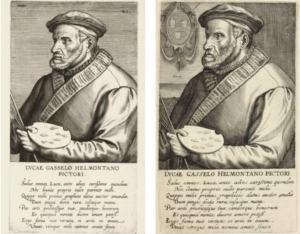
View the 1572 print
View both prints side by side
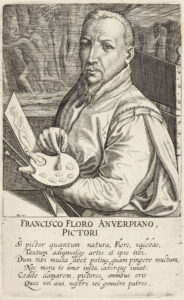
51. Frans Floris
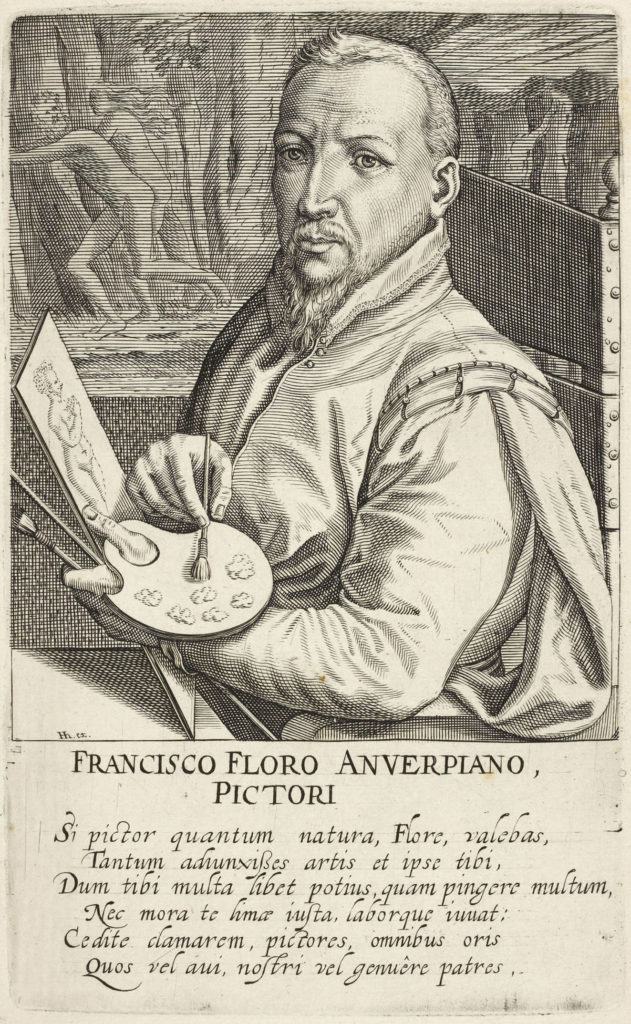
51. Frans Floris
Engraving
Signed 'Hh ex.' by Hendrick Hondius
Copy in same direction as Cock 1572 engraved Pictorum
20.5 x 12.5 cm
Transcription of Inscription [Lampsonius]:
FRANCISCO FLORO ANVERPIANO, PICTORI
Si pictor quantum natura, Flore, valebas,
Tantum adiunxisses artis et ipse tibi,
Dum tibi multa libet potius, quam pingere multum
Nec mora te limae iusta, laborque iuvat :
Cedite clamarem, pictores, omnibus oris
Quos vel avi, nostri vel genuêre patres.
Translation of Inscription [Lampsonius]:
To Frans Floris of Antwerp, painter
If, Floris you had acquired for yourself as much skill as you had natural ability as a painter (since you preferred to paint many things than to paint a lot,46 and neither the just delay of the file nor hard work47 pleased you) – I would cry out ‘yield painters from all lands,48 whom either our grandfathers or our fathers produced’.
Hollstein 1994 no.103
Karel Van Mander's biography of Frans Floris
Grove Art Online biography
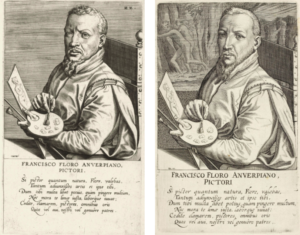
View the 1572 print
View both prints side by side
Footnotes:
- One of the muses. Cf. The poem on Lucas van Leyden, “nostrae ...Camenae”.
- “ope” could also mean “wealth”. Either way, it’s hard to see (without knowing the context) how Hubert will feel this adds to his praises.
- This for “vestrum”, which is plural, so the work is being credited to both brothers.
- “amore sui” could also mean “love of himself”, but I am presuming that the author is referring to the Lam Gods.
- “ille ego qui” – For the ultimate source of this phrase, see the apocryphal opening lines to the Aeneid, “ille ego qui quondam gracili modulatus avena…”
- “oleo de semine lini”: the same expression in the poem for Cornelis Engebrechtsz.
- This for “probitas”. It is hard to see quite what the author means, but “probitas” to my knowledge always has a moral sense.
- I am taking “rerum genetrice” as qualifying “arte” in the next line. This is awkward, but I cannot see a better solution.
- The entry to the underworld in Virgil’s Aeneid.
- The sense seems to be that Rogier painted as well as he could for his time. Compare to poem on Jan Gossaert
- The point seems to be that Rogier’s paintings will pass away, like all earthly things, whereas his works of mercy will gain him eternal life, and therefore last forever.
- I translate as if “doctissima” agrees with “Bernardus”. This is in fact impossible, as “doctissima” is feminine. It could agree with “aulica … Bruxella”, or be a vocative, addressing Margaret. But neither of these options makes much sense. Nor can it be corrected to “doctissimus” without spoiling the metre.
- The reference, which is found in classical poetry, is to Attalus III of Pergamum, credited with the invention of cloth of gold.
- "me iudice certet". Cf. Virgil, Eclogue 4, 58, "mecum si iudice certet".
- Cornelis Cort (c.1533-1578)
- “rura ... et casas”. The combination (also found in Lucas Gassel below) is from Virgil, Eclogues 2.28-29.
- A palimpset in this context probably means a printing plate on which previous incisions had been made and burnished out so that the plate could be used again.
- I am translating Lampsonius’ “amare”, not Hondius’ “amars”, which is not Latin
- Because the Cyclopes worked with hammers.
- See note 1
- The greatest of poets is Virgil, and the episode in question is Aeneid 8, 369-453 and 608-fin. The author seems to think of the images on Aeneas’ shield as paintings (Virgil himself does not say clearly how Vulcan made the pictures).
- “oleo de semine lini”: the same expression in the poem for Jan van Eyck
- This of course merely means “paintings”
- sic. Lampsonius' text in Pictorum aliquot celebrium Germaniae inferioris effigies reads "sive Deos".
- sic. Lamponius' text, cited above, reads 'in gnava'.
- I am reading “sive” for “sine” in line 2, and “gnava” for “guava” in line 4. Both corrections are from Lampsonius.
- This town’s name seems now to be spelt “Aalst” (French: “Alost”).
- sic. see note 2.
- Reading Lampsonius’ “urbes” for Hondius's impossible “urbis”.
- Can be translated as “Caesar” Cf. note on “Emperor” on the text for Albrecht Dürer, Anthony Mor and others
- See note on the text for Bernaert van Orley.
- This seems to mean that Vermeyen showed more skill in painting drapery than was involved in making the drapery itself.
- sic. see note 3.
- sic. see note 4.
- Reading Lampsonius’ “immortali” for Hondius’ “immortalis”. With the latter reading, one would translate “whom Belgium honours with praise [as] immortals”.
- Reading Lampsonius “tantum” for Hondius “tantem” (?), which is not Latin.
- Julius Caesar describes the “Eburones” as a Belgian people in the region “extending from Liège to Aix-la-Chapelle” (Lewis & Short). I cannot say which city the author considers the “urbs Eburonia”. Presumably Dinant itself.
- sic. See note 2.
- This line is unmetrical in the Latin, because Hondius has omitted Lampsonius’ “in” before “illa”. I translate according to Lampsonius.
- This for the Greek Λαμψονίοτε γραφίς. Λαμψονίοτε is apparently the author’s attempt to invent a Greek adjective based on his name. However, the form is bad Greek (better would be Λαμψονιοτὴ) and neither the author’s form nor mine will help the metre. The work by Lampsonius’s pen referred to is his biography of Lambert Lombard: Lamberti Lombardi apud Eburiones pictoris celeberrimi vita, Bruges, 1565.
- In the Latin, “eos” can only refer to “homines”, not “facies”. English cannot do this, so one would have to translate “looking at the people themselves”, vel sim. to avoid ambiguity.
- The renowned portraitist Anthonis Mor (c.1517/20 – c.1576), who was a friend of Lampsonius.
- sic.
- “rura casasque”. See note on the text for Joachim Patinir.
- I am reading Lampsonius’ “arti” for Hondius’ impossible “arte”. are your honesty and candour, and whatever
- The Latin “multa…multum” is equally vague. The sense seems to be that Floris preferred painting many works to expending much energy on any given one.
- The author is referring to Horace, Ars poetica 291, where “limae labor et mora” are recommended for the poet.
- Cf. Propertius, 2.34.65, “cedite Romani scriptores, cedite Grai” (about Virgil’s Aeneid). The implication is that Floris could have been as preeminent among painters as Virgil was among poets.

